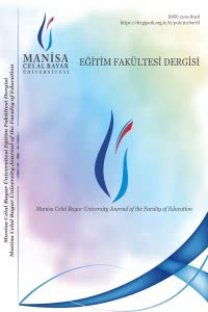Fizik Öğretmen Adaylarının Radyasyon Farkındalığı
Bu araştırmanın amacı fizik öğretmen adaylarının radyasyon ve radyoaktiviteye karşı tutum ve bilgi seviyelerini tespit etmektir. Çalışma grubunu, Dokuz Eylül Üniversitesi Buca Eğitim Fakültesi Fizik Öğretmenliği Bölümü 4. sınıfta öğrenim görmekte olan toplam 20 öğrenci oluşturmaktadır. Çalışmada betimsel tarama modeli kullanılmıştır. Veri toplama aracı olarak, öğretmen adaylarının radyasyona karşı tutum ve bilgi düzeylerini ölçmek amacıyla araştırmacılar tarafından sekiz adet açık uçlu soru hazırlanmıştır. Sorular radyasyon öğretiminden önce ve sonra olmak üzere iki kez uygulanmıştır. Araştırma sonucunda; radyoaktivite konusunun öğretiminden önce öğretmen adaylarının radyasyona karşı olumsuz yönde önyargılı bir tutuma sahip olduğu saptanmıştır. Konunun öğretiminden sonra ise öğretmen adaylarının büyük bir çoğunluğu radyasyonun zararlarının yanında büyük ölçüde yararlarının da olduğunun farkına varmış ve bunu doğru gerekçelerle ifade edebilmişlerdir.
Anahtar Kelimeler:
radyasyon farkındalığı, radyoaktivite, fizik öğretmen adayları
Prospective Physics Teachers’ Awareness of Radiation
The purpose of this study is to investigate prospective physics teachers’ knowledge of and attitude toward radiation and radioactivity. The study group consists of 20 students having education in Dokuz Eylül University Buca Education Faculty Physics Education Department 4th grade. This research has a descriptive survey approach. A questionnaire consisting eight open-ended questions related with the knowledge about radiation and attitude toward radiation was conducted by researches. Questions were applied twice before and after radiation education. At the end of the research, it was determined that prospective physics teachers have a negative attitude with prejudice before radiation education. After education of the subject most of them realized the benefits of radiation as well as harms and were able to express it with correct justification.
___
- Alsop, S., Hanson, J., & Watts, M. (1998). Pupils’ Perception of Radiation and Radioactivity: The Wary Meet the Unsavoury. Sch. Sci. Rev., 72 (289), 75-80.
- Alsop, S. (2001). Living with and Learning about Radioactivity: A Comparative Conceptual Study. International Journal of Science Education, 23(3), 263–281.
- Anderson, B. (1986). Pupil’s Explanations of Some Aspect of Chemical Reactions. Science Education, 70(5), 549-563.
- Bakac, M., Kartal Tasoglu, A., & Uyumaz, G. Modeling Radioactive Decay. Procedia Social and Behavioral Sciences, 15, 2196-2200.
- Cooper, S., Yeo, S., & Zadnik, M. (2003). Australian Students’ View on Nuclear Issues: Does Reaching Alter Prior Beliefs? Physics Education, 38, 123-129.
- Colclough, N. D., Lock, R., & Soares, A. (2010). Pre-Service Teachers’ Subject Knowledge of and Attitudes About Radioactivity And Ionising Radiation. International Journal of Science Education, 1-24.
- Durant, J.R., Evans, G. A., & Thomas, G.P. (1989).The Public Understanding of Science. Nature, 340,11-14.
- Eijkelhof, H.M., & Millar, R. (1988). Reading about Chernobyl: The Public Understanding of Radiation and Radioactivity. School Science Review, 70, 35– 41.
- Gezgin, Z. ve Güneş, G. (2003). Gıdaların Gama Işınları ile Muhafazası. Gıda Dergisi, 82-87.
- Gökmen,A., Atik, A.D., Ekici, G., Cimen, O., & Altunsoy, S. (2010).Analysis of High School Students’ Opinions on the Benefits and Harms of Nuclear Enery in terms of Environmental Values. Procedia Social and Behavioral Sciences, 2(2), 2350-2356.
- Furuta, M., Hayashi, T., Kakefu, T. & Nishihara H. (2000). Public Status toward Radiation and Irradiated Potatoes at “Youngster’s Science Festival” in Several Cities Including Tokyo, Osaka,and Hiroshima, Japan.Radiation Physics and Chemistry, 57, 325-328.
- Henriksen, E. K. (1996). Laypeople’s Understanding of Radioactivity and Radiation. Radiation Protection Dosimetry, 68(3/4), 191-196.
- Henriksen, E.K., & Jorde, D. (2001). High School Students’ Understanding of Radiation and the Environment: Can Museums Play a Role? Science Education, 85(2), 189-206.
- Ince,E., Sesen, B.A., & Kırbaslar, F.G. (2012). Investigation of Undergraduate Students’ Understanding of Radiation and Radioactivity. Energy Education Science and Technology Part B-Social and Educational Studies, 4, 993-1004.
- Lijnse, P.L., Eijkelhof, H.M.C., Klaassen, C.W.J.M., & Scholte, R.L.J. (1990). Pupil’s and Mass Media Ideas about Radioactivity. International Journal of Science Education, 12(1), 67–78.
- Mancl, K., Heimlich, J., Fentiman, A., & Christensen, R. (1994). General Public Awareness of Sources of Radiation in Their Environment. Ohio Journal of Science, 94(5), 134-137.
- Mavi, Mehtap (2008). Lise Öğrencilerinin Radyasyon Konusundaki Kavram Yanılgılarının Tespiti.Yayınlanmış Yüksek Lisans Tezi. Süleyman Demirel Üniversitesi Fen Bilimleri Enstitüsü, Isparta.
- Millar, R., Klaassen, C.W.J.M., & Eijkelhof, H.M.C. (1990). Teaching about Radioactivity and Ionising Radiation: An Alternative Approach. Physics Education, 25, 338–342.
- Morgil, İ., Yılmaz, A. ve Uludağ, N. (2004). Lise Kimya 2 Ders Kitabında Yer Alan Radyoaktivite Konusunun İncelenmesi, Öğrencilerin Bu Konudaki Bilgilerinin Araştırılması ve Öneriler. Hacettepe Üniversitesi Eğitim Fakültesi Dergisi, 27, 206-215.
- Prather, E.E. (1998). Research on the Teaching and Learning of Radiation and Radioactivity. Chapter 8.Graduate Students and Post Doctoral Students Discuss Their Thesis Research. PERC, 101-102.
- Prather, E. E. & Harrington, R. R. (2001). Student Understanding of Ionizing Radiation and Radioactivity. Journal of College Science Teaching, 31 (2), 89-93.
- Rego, F. & Peralta, L. (2006). Portuguese Students’ Knowledge of Radiation Physics. Physics Education, 41(3), 259-262.
- Ronneau, C. (1990). Radioactivitiy: A Natural Phenomenon. Journal of Chemical Education, (67)9, 736-737.
- Sesen, B.A. & Ince, E. (2010).Internet as a Source of Misconception: “Radiation and Radioactivity”, The Turkish Online Journal of Educational Technology, 9(4), 94- 100.
- ISSN: 1309-8918
- Başlangıç: 2011
- Yayıncı: MANİSA CELÂL BAYAR ÜNİVERSİTESİ
Sayıdaki Diğer Makaleler
Yeni İlköğretim 6. Sınıf Matematik Programının Öğrenci Ve Öğretmenlerce Değerlendirilmesi
Seher GÜLEŞ DAĞLAR, Ahmet DELİL
Ayşegül CELEP, Özlem GÜLTEKİN, Sevilay KARAMUSTAFAOĞLU, Orhan KARAMUSTAFAOĞLU
Yapılandırılmış Laboratuvar Uygulamalarının Ortaokul Öğrencilerinin Bilimsel Araştırma Görüşleri
Yavuz SAKA, Süleyman YAMAN, Canan TUNÇ ŞAHİN, Canan PEKBAY, Zuhal GERÇEK
Fizik Öğretmen Adaylarının Radyasyon Farkındalığı
